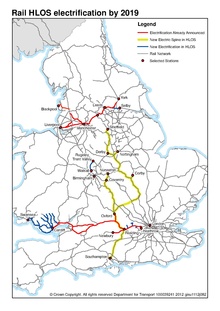
Midland Mainline was a train operating company in the United Kingdom owned by National Express that operated the Midland Main Line franchise from April 1996 until November 2007. Midland Mainline ran fast and semi-fast passenger services from London to the East Midlands and Yorkshire, on the Midland Main Line. Most services ran between London St Pancras and either Derby, Nottingham or Sheffield. Some services extended to Burton upon Trent, Matlock, Barnsley, Leeds, York and Scarborough.
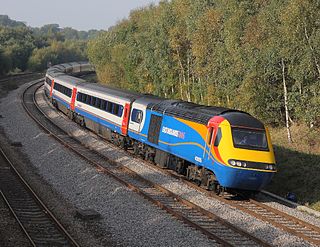
The Midland Main Line is a major railway line in England from London to Sheffield in Yorkshire via the East Midlands. It comprises the lines from London's St Pancras station via Leicester, Derby/Nottingham and Chesterfield.

Leicester railway station is a mainline railway station in the city of Leicester in Leicestershire, England. The station is managed by East Midlands Railway and owned by Network Rail. The station is served by CrossCountry and East Midlands Railway services.
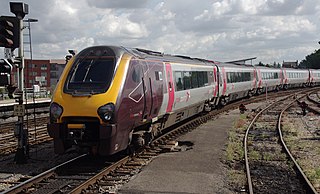
The CrossCountry NE–SW route is a long-distance rail route in England. It runs from Bristol Temple Meads to York via Birmingham New Street, Derby, Sheffield and Leeds or Doncaster. It facilitates some of the longest passenger journeys in the UK such as Aberdeen to Penzance.
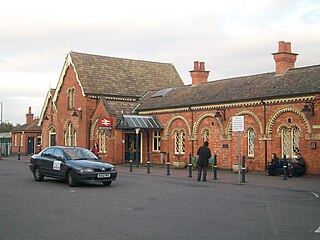
Wellingborough railway station is a Grade II listed station located in the market town of Wellingborough in Northamptonshire, England. It lies on the Midland Main Line and is 65 miles (104 km) from London St. Pancras. The station is operated by East Midlands Railway, which is also the primary operator serving the station with passenger services.

Kettering railway station serves the town of Kettering in Northamptonshire, England. It lies south-west of the town centre, on the Midland Main Line, 71 miles (115 km) north of London St. Pancras.

Market Harborough railway station is a Grade II listed station which serves the town of Market Harborough in Leicestershire, England. It is situated to the east of the town centre and lies on the Midland Main Line, 16 miles (26 km) south-east of Leicester.

Loughborough railway station is a Grade II listed railway station in the town of Loughborough, Leicestershire, on the Midland Main Line, 111 miles (179 km) north of London St Pancras. The station is north-east of the town centre.

East Midlands Parkway railway station is located north of Ratcliffe-on-Soar on the Midland Main Line in the East Midlands of England. It provides park and ride facilities for rail passengers on the routes from Leicester to Derby and Nottingham. It is also the closest station to East Midlands Airport, some 4 miles (6.4 km) away, but without public transport link.

Beeston railway station is a Grade II listed railway station on the Midland Main Line which serves the town of Beeston in Nottinghamshire, England. It lies 3.2 miles (5.1 km) south-west of Nottingham railway station, and 750 metres (0.5 mi) south-east of Beeston transport interchange for local buses and Nottingham Express Transit trams. The station is managed by East Midlands Railway.

Corby railway station, owned by Network Rail and managed by East Midlands Railway, is in Corby, Northamptonshire, England. The current station, opened on 23 February 2009, replaces an earlier one dating from 1879, first closed on 18 April 1966 but reopened between 1987 and 1990.

Melton Mowbray railway station serves the market town of Melton Mowbray in Leicestershire, England. It is owned by Network Rail and operated by East Midlands Railway, though CrossCountry operates most of the services as part of its Birmingham New Street to Stansted Airport route. The station is on the route of the Syston and Peterborough Railway, which is now part of the Birmingham to Peterborough Line. It has a ticket office, which is staffed part-time, a car park, and help points for times when no staff are present.
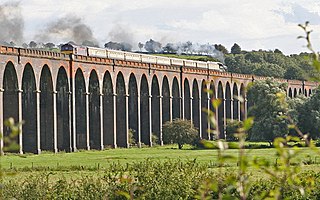
The Oakham–Kettering line is a railway line in the East Midlands of England. Currently it has one passenger station in operation, at Corby.

Railway electrification in Great Britain began in the late 19th century. A range of voltages has been used, employing both overhead lines and conductor rails. The two most common systems are 25 kV AC using overhead lines, and the 750 V DC third rail system used in Southeast England and on Merseyrail. As of March 2020, 3,758 miles (6,048 km) (38%) of the British rail network was electrified.

East Midlands Trains (EMT) was a British train operating company owned by the transport group Stagecoach, which operated the East Midlands franchise between November 2007 and August 2019.
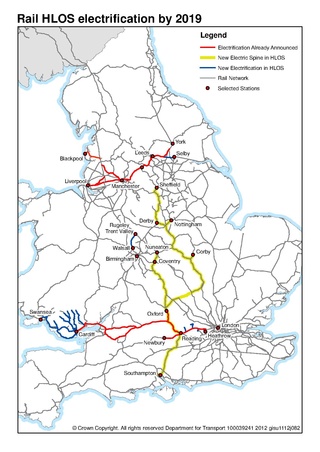
The "Electric Spine" was the name for part of a, now largely cancelled, rolling programme of railway electrification projects in England initially estimated to cost £800 million, but later thought to cost close to £3 billion. The aim was to form 25 kV AC overhead-wire electrified links northward from the Port of Southampton to major cities in northern and central England and a dry port container terminal in the Midlands. The government wanted efficient electric-hauled freight trains to compete with road haulage.
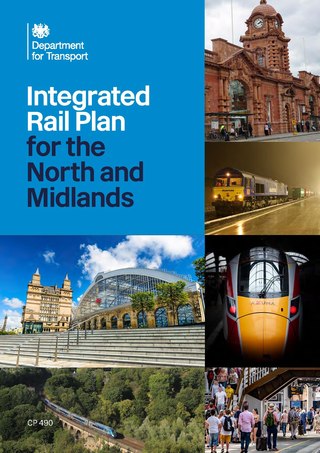
The Integrated Rail Plan for the North and Midlands or more simply, the Integrated Rail Plan (IRP), is a United Kingdom government proposal published on 18 November 2021. It aims to deliver "increased capacity, faster journeys or more frequent services on eight out of the top ten busiest rail corridors across the North and Midlands", by developing rail services along with the required infrastructure in these regions of England. It was published by the Department for Transport (DfT) and features forewords by Prime Minister Boris Johnson and Transport Secretary Grant Shapps, but its publication was delayed a number of times, partly because of the COVID-19 pandemic. It contains the significant proviso that "In line with the Government's existing approach to rail enhancements, commitments will be made only to progress individual schemes up to the next stage of development, subject to a review of their readiness." A Technical Annexe was published in January 2022. A correction slip was issued March 2022.
The Felixstowe to Nuneaton railway upgrade in the United Kingdom is a series of upgrades being made to both a key strategic freight route and one that carries passengers on many parts. It is one of only two routes between the busiest container port and the midlands, the other being via London. The route and the upgrade is sometimes abbreviated to F2N. The railway route includes the Birmingham–Peterborough line for a large part. The line links the Port of Felixstowe in Felixstowe, Suffolk, with the Midlands and crosses the East Coast Main Line, the Midland Main Line and the West Coast Main Line and thus the north. From Nuneaton, a number of intermodal terminals maybe reached. Much infrastructure in the UK is of Victorian origin and thus needed an upgrade; F2N, being a key route, is no exception.
The Nottingham direct line of the Midland Railway was a new route created in 1879 to relieve congestion on the established routes of the Midland Railway, in England. It consisted of two connecting lines that, together with part of an existing route, formed a new route from Nottingham to near Kettering. The line was used for Nottingham to London express passenger trains, and for heavy mineral and goods trains heading south. As well as shortening the transit a little, the new line had the effect of relieving congestion on the original main line through Leicester, that had become excessively congested.
